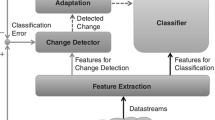Abstract
In Wireless Sensor Network (WSN) applications, sensor nodes are often deployed in harsh environments. Routine maintenance, fault detection and correction is difficult, infrequent and expensive. Furthermore, for long-term deployments in excess of a year, a node’s limited power supply tightly constrains the amount of processing power and long-range communication available.
In order to support the long-term autonomous behaviour of a WSN system, a self-diagnostic algorithm implemented on the sensor nodes is needed for sensor fault detection. This algorithm has to be robust, so that sensors are not misdiagnosed as faulty to ensure that data loss is kept to a minimum, and it has to be light-weight, so that it can run continuously on a low power microprocessor for the full deployment period. Additionally, it has to be self-adapative so that any long-term degradation of sensors is monitored and the self-diagnostic algorithm can continuously revise its own rules to accomodate for this degradation. This paper describes the development, testing and implementation of a heuristically determined, robust, self-diagnostic algorithm that achieves these goals.
Preview
Unable to display preview. Download preview PDF.
Similar content being viewed by others
References
PROSEN. Prosen project homepage (2007), [Online] available: http://www.prosen.org.uk
Caselitz, P., Giebhardt, J., Mevenkamp, M.: Application of condition monitoring systems in wind energy converters. In: European Wind Energy Conference (EWEC 1997), Dublin, October 1997 (1997)
Angeli, C., Chatzinikolaou, A.: On-line fault detection techniques for technical system: A survey. International Journal of Computer Science & Applications I(1), 12–30 (2004)
Roumeliotis, S.I., Sukhatme, G.S., Bekey, G.A.: Sensor fault detection and identification in a mobile robot. In: 1998 IEEE International Conference on Robotics and Automation, May 1998, pp. 2223–2228. IEEE Computer Society Press, Los Alamitos (1998)
de Freitas, N., Dearden, R., Hutter, F., Morales-Menendez, R., Mutch, J., Poole, D.: Diagnosis by a waiter and a mars explorer. Proceedings of IEEE 92(3), 455–468 (2004)
Goel, P., Dedeoglu, G., Roumeliotis, S.I., Sukhatme, G.S.: Fault detection and identification in a mobile robot using multiple model estimation and neural network. In: IEEE International Conference on Robotics and Automation, Leuven, Belgium, May 1998, IEEE Computer Society Press, Los Alamitos (1998)
Ramanathan, N., Balzano, L., Burt, M., Estrin, D., Harmon, T., Harvey, C., Jay, J., Kohler, E., Rothenberg, S., Srivastava, M.: Rapid deployment with confidence: Calibration and fault detection in environmental sensor networks, Center for Embedded Networked Sensing, UCLA and Department of Civil and Environmental Engineering, MIT, Tech (April 2006)
Koushanfar, F., Potkonjak, M., Sangiovanni-Vincentelli, A.: On-line fault detection of sensor measurements. In: Sensors, 2003. Proceedings of IEEE, October 2003, pp. 974–979. IEEE Computer Society Press, Los Alamitos (2003)
Bertrand-Krajewski, J., Bardin, J., Mourad, M., Beranger, Y.: Accounting for sensor calibration, data validation, measurement and sampling uncertainities in monitoring urban drainage systems. Water Science and Technology 47(2), 95–102 (2003)
Chen, J., Kher, S., Somani, A.: Distributed fault detection of wireless sensor networks. In: DIWANS 2006: Proceedings of the 2006 workshop on Dependability issues in wireless ad hoc networks and sensor networks, Los Angeles, CA, USA, pp. 65–72 (2006)
Davis instruments, wireless vantage pro2 specifications (2006), [Online]. available: http://www.davisnet.com/support/weather/
CR200 Series Datalogger with Spread Spectrum Radio, Campbell Scientific, Inc. (2005)
RF401/RF411/RF416 Spread Spectrum Data Radio/Modem, Campbell Scientific, Inc. (2005)
Li, H., et al.: (In prep. 2007)
Stott, J.: Canterbury weather website (2006), [Online]. available: http://www.canterburyweather.co.uk/
Uk weather extremes (2007), [Online]. available: http://www.metoffice.gov.uk/climate/uk/extremes/index.html
Model 109 Temperature Probe User guide. Campbell Scientific Inc. (2002)
Press, W.H., Teukolsky, S.A., Vetterling, W.T., Flannery, B.P.: Numerical recipes in C. Cambridge university press, New York, USA (1992)
Gumstix. Gumstix homepage (2007), [Online]. available: http://www.gumstix.com
Author information
Authors and Affiliations
Editor information
Rights and permissions
Copyright information
© 2007 Springer-Verlag Berlin Heidelberg
About this paper
Cite this paper
Li, H., Price, M.C., Stott, J., Marshall, I.W. (2007). The Development of a Wireless Sensor Network Sensing Node Utilising Adaptive Self-diagnostics. In: Hutchison, D., Katz, R.H. (eds) Self-Organizing Systems. IWSOS 2007. Lecture Notes in Computer Science, vol 4725. Springer, Berlin, Heidelberg. https://doi.org/10.1007/978-3-540-74917-2_5
Download citation
DOI: https://doi.org/10.1007/978-3-540-74917-2_5
Publisher Name: Springer, Berlin, Heidelberg
Print ISBN: 978-3-540-74916-5
Online ISBN: 978-3-540-74917-2
eBook Packages: Computer ScienceComputer Science (R0)




